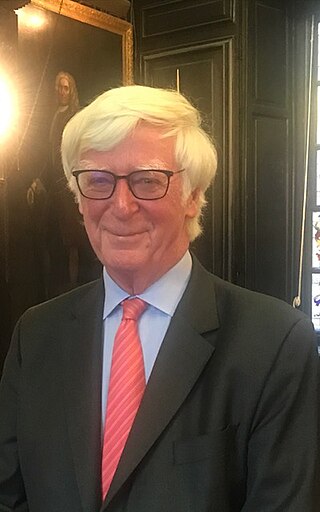
Orthopedic surgery or orthopedics is the branch of surgery concerned with conditions involving the musculoskeletal system. Orthopedic surgeons use both surgical and nonsurgical means to treat musculoskeletal trauma, spine diseases, sports injuries, degenerative diseases, infections, tumors, and congenital disorders.

Lumbar spinal stenosis (LSS) is a medical condition in which the spinal canal narrows and compresses the nerves and blood vessels at the level of the lumbar vertebrae. Spinal stenosis may also affect the cervical or thoracic region, in which case it is known as cervical spinal stenosis or thoracic spinal stenosis. Lumbar spinal stenosis can cause pain in the low back or buttocks, abnormal sensations, and the absence of sensation (numbness) in the legs, thighs, feet, or buttocks, or loss of bladder and bowel control.

Degenerative disc disease (DDD) is a medical condition typically brought on by the aging process in which there are anatomic changes and possibly a loss of function of one or more intervertebral discs of the spine. DDD can take place with or without symptoms, but is typically identified once symptoms arise. The root cause is thought to be loss of soluble proteins within the fluid contained in the disc with resultant reduction of the oncotic pressure, which in turn causes loss of fluid volume. Normal downward forces cause the affected disc to lose height, and the distance between vertebrae is reduced. The anulus fibrosus, the tough outer layers of a disc, also weakens. This loss of height causes laxity of the longitudinal ligaments, which may allow anterior, posterior, or lateral shifting of the vertebral bodies, causing facet joint malalignment and arthritis; scoliosis; cervical hyperlordosis; thoracic hyperkyphosis; lumbar hyperlordosis; narrowing of the space available for the spinal tract within the vertebra ; or narrowing of the space through which a spinal nerve exits with resultant inflammation and impingement of a spinal nerve, causing a radiculopathy.

Spondylolisthesis is when one spinal vertebra slips out of place compared to another. While some medical dictionaries define spondylolisthesis specifically as the forward or anterior displacement of a vertebra over the vertebra inferior to it, it is often defined in medical textbooks as displacement in any direction.

Spinal fusion, also called spondylodesis or spondylosyndesis, is a surgery performed by orthopaedic surgeons or neurosurgeons that joins two or more vertebrae. This procedure can be performed at any level in the spine and prevents any movement between the fused vertebrae. There are many types of spinal fusion and each technique involves using bone grafting—either from the patient (autograft), donor (allograft), or artificial bone substitutes—to help the bones heal together. Additional hardware is often used to hold the bones in place while the graft fuses the two vertebrae together. The placement of hardware can be guided by fluoroscopy, navigation systems, or robotics.
Jack Elliot Zigler is a Board Certified orthopedic surgeon specializing in spine surgery at the Texas Back Institute in Plano, Texas. He is best known for being the first surgeon to perform a ProDisc artificial disc replacement surgery in the United States, on October 3, 2001.

Paul Randall Harrington was an American orthopaedic surgeon. He is best known as the designer of the Harrington Rod, the first device for the straightening and immobilization of the spine inside the body. It entered common use in the early 1960s and remained the gold standard for scoliosis surgery until the late 1990s. During this period over one million people benefited from Harrington's procedure.
Robert S. Biscup is an American orthopaedic surgeon.

Sean Patrick Francis Hughes is emeritus professor of orthopaedic surgery at Imperial College London where he was previously professor of orthopaedic surgery and head of the department of surgery, anaesthetics and intensive care. Earlier in his career he had been professor of orthopaedic surgery at the University of Edinburgh.
Sean E. McCance is an American orthopedic surgeon and Co-Director of Spine Surgery in the Leni and Peter W. May Department of Orthopaedics at the Mount Sinai Medical Center in New York City. Additionally, he is an Associate Clinical Professor of Orthopaedics at the Mount Sinai School of Medicine and Attending Spine Physician at Lenox Hill Hospital.
Andrew C. Hecht is an American orthopaedic surgeon and a nationally recognized leader in surgery on the spine.
Minimally invasive spine surgery, also known as MISS, has no specific meaning or definition. It implies a lack of severe surgical invasion. The older style of open-spine surgery for a relatively small disc problem used to require a 5-6 inch incision and a month in the hospital. MISS techniques utilize more modern technology, advanced imaging techniques and special medical equipment to reduce tissue trauma, bleeding, radiation exposure, infection risk, and decreased hospital stays by minimizing the size of the incision. Modern endoscopic procedures can be done through a 2 to 5 mm skin opening. By contrast, procedures done with a microscope require skin openings of approximately one inch, or more.
Arthur L. Jenkins III is an American fellowship-trained neurosurgeon, co-director of the Neurosurgical Spine Program, and Director of Spinal Oncology and Minimally Invasive Spinal Surgery (MIS) Program at the Mount Sinai Hospital, New York. Additionally, he is an associate professor of Neurosurgery and of Orthopedic Surgery at the Mount Sinai School of Medicine. Dr. Jenkins has multiple patents and patent applications for spine-related implants and support systems, and is developing new minimally invasive treatments for patients with cancer that has spread to the spine. He is an innovator in the treatment of acute spinal cord injury as well as degenerative and congenital anomalies of the spine, taking a minimally invasive or minimal-impact approach where possible. He is board certified in Neurological Surgery and is licensed in New York and Connecticut.

Parviz Kambin was an American-Iranian medical doctor and orthopaedic surgeon. He was a Professor of Orthopaedic Surgery and has established an Endowed Chair of Spinal Surgery Research at Drexel University College of Medicine. He published more than 55 articles in peer-reviewed journals, edited two textbooks and contributed chapters in spinal surgery textbooks. He lectured worldwide in the field of minimally invasive spinal surgery. His research and development in this specialty began in 1970.

Xenco Medical is an American medical technology company headquartered in San Diego, California that designs, develops, and distributes composite polymer medical devices.
The Philadelphia Surgery Center is a medical facility in Narberth, Pennsylvania, that specializes in small-scale endoscopic spine surgery for the treatment of spinal stenosis and herniated or fragmented spinal discs.

NuVasive, Inc. is a medical devices company based in San Diego, California. Founded in 1997, it primarily develops medical devices and procedures for minimally invasive spine surgery.
Ralph Mobbs is an Australian neurosurgeon who specialises in spinal surgery. He operates at Prince of Wales Private and Public Hospital. He is an Associate Professor of Neurosurgery at the University of New South Wales.

Thomas Schuler, M.D., F.A.C.S is an American spinal surgeon, researcher and educator in the treatment of neck and low back conditions. He was an early adopter of stem cell therapy, biologics, robotics, laser and hybrid surgery and augmented reality for spinal surgery. Schuler specializes in cervical and lumbar disc replacement procedures, minimally invasive spine surgery and robotic spine surgery. He performed the first hybrid multi-level cervical artificial disc replacement with spinal fusion in the country. He founded a practice that has performed some of the first robotic and augmented reality spinal surgeries in the world. In 2002 he created and currently serves as President of the National Spine Health Foundation, a national non-profit focused on education, research and patient advocacy of neck and back health.
Justin Peter Cobb is a British professor of orthopaedic surgery at Imperial College London, known for introducing medical robotics into orthopaedic surgery. He is a member of the Royal Medical Household and was royal orthopaedic surgeon to the Queen. He is on the staff at King Edward VII's Hospital (KEVII) and is civilian advisor in orthopaedics to the Royal Air Force (RAF). His research has also included themes relating to designing new devices such as for ceramic hip resurfacing, 3D printing in orthopaedics, and training in surgical skills. He is a director of the MSk laboratory based in the Sir Michael Uren Hub.










